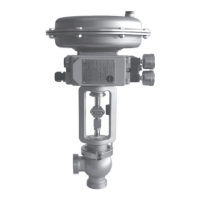10 EB 8097 EN
Assembling valve and actuator
9. Align travel indicator scale (5.5) with the
tip of the stem connector; for actuators
with fail-safe action "actuator stem ex-
tends" align it with lower marking (valve
closed) and for actuators with fail-safe
action "actuator stem retracts" align it
with top marking (valve open).
Note on removing an actuator
When removing an actuator with "stem ex-
tends" fail-safe action from a valve and es-
pecially an actuator with preloaded springs,
apply a signal pressure that is slightly higher
than the lower bench range value (see actu-
ator nameplate) to the lower signal pressure
connection to allow the ring nut (8) to be
loosened.
3.2 Option of preloading
springs for "actuator stem
extends"
To achieve a greater positioning force, the
springs of the actuators can be preloaded by
up to 25% of their travel or their bench
range.
When a preload of, e.g. 0.1bar, is desired
for a bench range of0.2 to 1bar, the lower
bench range value is shifted by 0.1bar to
0.3bar (0.1bar correspond to a preload of
12.5%).
When adjusting the valve, set the lower
bench range value to 0.3bar. Write the new
bench range with preloaded springs of 0.3
to 1.1bar on the nameplate.
3.3 Different rated travels of
valve and actuator
Actuators that have already been preloaded
by the manufacturer without mounting the
valve are labeled correspondingly. Addition-
ally, they can be identied by three longer
bolts with nuts protruding from the bottom
diaphragm case.
Always use actuators with preloaded springs
when the valve's rated travel is smaller than
the rated travel of the actuator.
GEFAHR
!
WARNING
!
NOTICE
!

